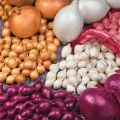Seeds and Supplies
Great selection of seeds and supplies in stock. Please see in store for Selection.Promotion
All Ontario Seed Company (OSC) and Aimers Organic Seeds are 10% Off regular retail price for a limited time. See in store for full selection. Not every item is listed on our website. Seeds are this years supply and are fresh ready to plant
Seeds Peas Snow Peas Oregon Sugar Pod II OSC Seed Packet
Oregon Sugar Pod II Pea Seeds (Edible Pod Type) . Plants vary in height from 40-75 cm (16-30″) and produce 10 cm (4″) long, light green pods about 2 cm (3/4″) wide. Generally there are two pods per cluster. The pods are quite suitable for eating fresh, stir-fried or for freezing. This improved snow pea variety is resistant to many viruses, powdery mildew and common wilt. White flowers.
How to Grow
Peas are a cool weather crop and can be sown from early April through to mid- May when the soil temperature is between 10-16 C (50-60 F). Fall crops are possible in hardiness zones 6 & 7. Sow in double rows spaced 25 cm (10″) with the seed 6.5 cm (2.5″) apart within the row and 1.25-2.5 cm (1/2-1″) deep. Space each set of double rows 75 cm (2.5′) apart. Peas can also be sown in blocks 120 cm (48″) square with the seeds spaced 6.5 cm (2.5″) apart within the block. Sow successive crops 10-14 days apart for extended harvests. Keep the soil evenly moist during the germination period or emergence will be spotty. You can stake or support row planted bush varieties for easier picking – climbing varieties definitely need to be supported. Avoid the use of high nitrogen fertilizers. Once flowering starts, it is important to keep the plants well watered to produce a good harvest. As the pods mature, pick daily to enjoy their peak flavour and to encourage more pods to form. Careful cultivation between rows is recommended to increase harvest yield. Removing clover and other non-crop legumes from the vicinity of the pea crop will reduce pest problems.
Seeds Pepper California Wonder Aimers Organic Seed Packet
(Bell Type) 1945 Heirloom Vegetable. Early Calwonder produces sturdy plants 75 cm (30″) high producing large, very mild fruit that are particularly sweet. Peppers are 4-lobed and average 11 cm (4″) long and 7.5-10 cm (3-4″) wide. The flesh is thick and solid starting as a deep green and ripening to a deep scarlet. Probably the nicest looking and best tasting standard bell pepper.
How to Grow
Start indoors mid February to late March. Use a soil-less growing mix. Sow seed 6 mm (1/4″) deep. Maintaining the growing medium at a temperature of 21 C (70 F) will enhance germination. Grow the seedlings under bright light and temperatures of 16-21 C (60-70 F) to produce strong, stocky plants. Transplant after hardening off, in late May to early June. Full sun and a well-drained soil is best. Space the plants 30 cm (12″) apart in rows spaced 60 cm (24″) apart. Control weeds and avoid high nitrogen fertilizers. Try harvesting the peppers at different maturities to experience a wider range of flavours and textures. Staking is recommended with most varieties. Note: Estimated days to maturity are based on counting the days after transplanting.
Seeds Pepper Jalapeno (Hot) Aimers Organic Seed Packet
(Hot Chili Type) Jalapeño has moderately intense heat with some years producing peppers that are hotter than others. Irregular sized fruit averaging 9 cm (3.5″) long by 4 cm (1-1/2″) wide are produced in large amounts on plants growing 60 cm (2′) in height. Thick walled, very pungent dark green fruit turn red at maturity. An eye watering addition to salsa and dips and great for pickling. How about making some chile rellenos! Stuff with cheese, coat in batter and fry. Scoville Heat Unit Rating – 6000.
Scoville Heat Units – The Scoville heat unit (SHU) rating is your guide to the perceived hotness of peppers caused by the active component capsaisin. The scale runs from about 2500 SHU for the mildest Anaheim to several million SHU. Our hottest is the Carribean Red Hot at 400,000 SHU.
How to Grow
Start indoors mid February to late March. Use a soil-less growing mix. Sow seed 6 mm (1/4″) deep. Maintaining the growing medium at a temperature of 21 C (70 F) will enhance germination. Grow the seedlings under bright light and temperatures of 16-21 C (60-70 F) to produce strong, stocky plants. Transplant after hardening off, in late May to early June. Full sun and a well-drained soil is best. Space the plants 30 cm (12″) apart in rows spaced 60 cm (24″) apart. Control weeds and avoid high nitrogen fertilizers. Try harvesting the peppers at different maturities to experience a wider range of flavours and textures. Staking is recommended with most varieties. Note: Estimated days to maturity are based on counting the days after transplanting.
Seeds Pumpkin Big Max OSC Seed Packet
Look for help when it’s time to bring these beauties in from the garden. “Big Max” lives up to his name by producing large pumpkins, reliably in the 20 kg (44 lbs) range. When growing conditions are ideal, this pumpkin will produce fruit that weigh more than 45 kg (100 lbs) measuring in at 175 cm (70″) in diameter. Fruit tends to have a “flattened” appearance. The skin is pinkish orange and very thick. ‘Big Max’ is usually listed as C. maxima rather than C. pepo.
How to Grow
Pumpkin is a hot weather crop. They need full sun and deep, rich, well drained, organic soil with a pH of 5.5 to 6.5. Before planting, work in lots of compost. Sow seed directly outdoors from late May through early June 2.5 cm (1″) deep in hills 2.4 m (8′) apart with 4-6 seeds per hill. After germination, thin to 3 plants per hill. Seed can be started indoors 3 weeks before the plant out date. Pumpkins do not transplant well–use paper or fibre pots that can be set directly in the soil. For competition sized pumpkins, allow only two pumpkins per plant to mature. Protect mature pumpkins from frost and cold temperatures.
Seeds Pumpkin Jack Be Little OSC Seed Packet
Jack-Be-Little Pumpkin Seeds (Ornamental Type) . As the name implies, ‘Jack-Be Little’ produces miniature pumpkins, approximately 5 cm (2″) tall, 7.5 cm (3″) in diameter and cute as a button! Although they are edible, they are most often used for table decorations and miniature Jack o ‘Lanterns. When properly cured, these pumpkins will last up to 8 months.
How to Grow
Pumpkin is a hot weather crop. They need full sun and deep, rich, well drained, organic soil with a pH of 5.5 to 6.5. Before planting, work in lots of compost. Sow seed directly outdoors in late May through early June 2.5 cm (1″) deep in hills 2.4 m (8′) apart with 4-6 seeds per hill. After germination, thin to 3 plants per hill. Seed can be started indoors 3 weeks before the plant out date. Pumpkins do not transplant well–use paper or fibre pots that can be set directly in the soil.
Seeds Pumpkin Small Sugar Aimers Organic Seed Packet
HEIRLOOM. An older, smaller variety of the Connecticut Field pumpkin.
Full Description
Small Sugar is even better for pies than its larger cousin Connecticut Field pumpkin. When Mr. Burpee offered it in 1887 he said: "A very prolific and handsome little pumpkin; usual size about 10" in diameter; skin is a deep orange-yellow. It is very fine-grained, sweet and sugary, and keeps well."
Seeds Radish Cherry Belle OSC Seed Packet
All America Selections winner. Brightly flavored and crunchy, this fine heirloom radish makes for great fresh eating all season. Round, smooth, scarlet ¾" roots with tangy, white flesh are perfect candidates for crudités, salads, or soups. Outstanding roasted, mingled with lemon and brown butter (radish tops included).
Seeds Radish French Breakfast Aimers Organic Seed Packet
Bright rose scarlet at the top with white blunt tips, this popular heirloom radish is 5cm (2") long and perfect for enjoying raw in salads. This variety grows well from spring through summer with upright tops that grow to about 15cm (6") tall. Gather and refrigerate for best storage. This variety has been in cultivation since the 1880s, which speaks to its reliability, flavour, and charm.
Seeds Radish French Breakfast OSC Seed Packet
Bright rose scarlet at the top with white blunt tips, this popular heirloom radish is 5cm (2") long and perfect for enjoying raw in salads. This variety grows well from spring through summer with upright tops that grow to about 15cm (6") tall. Gather and refrigerate for best storage. This variety has been in cultivation since the 1880s, which speaks to its reliability, flavour, and charm. Learn when to plant radish seeds in our How to Grow Radishes instructions below. Be sure to sow some French Breakfast radish seeds in your organic vegetable garden.
Matures in 25-30 days.
Seeds Radish Minowase Hybrid OSC Seed Packet
50 days. (Japanese Daikon) Best variety for fall harvests. Long 16 in/40cm, tapered 2 1/2 in./51/4 cm thick, crisp, pure white roots have white necks, medium/tall tops. Pungent/mild hot taste. Tolerant to Mosaic Virus, Fusarium and heat.
Seeds Radish Scarlet Globe OSC Seed Packet
Scarlet Globe Radishes are a time honored favorite. The olive shaped fruit grow to a medium sized 2.5 cm (1"). Dazzling scarlet-red skins give way to crispy and crunchy white centers with delicate flavor. This cool weather crop is perfect for any garden.Seed Type: Heirloom
Flavor: Crunchy, crisp, with peppery flavor
Days to Harvest: 20 to 25 days
Days to Seed Germination: 4 to 7 days
Seed Planting Depth: 1.3 cm (1/2")
Row Spacing: 30 cm (12")
Plant Spacing: 5 cm (2")
Planting Instructions: Make several plantings, 10 days apart until the weather becomes warm. May be sown again when weather cools for a fall crop. Plant in moist, well drained soil, as soon as ground can be worked and danger of frost has passed.
Seeds Root Parsley Hamburg OSC Seed Packet
Hamburg Root Parsley Seeds (Turnip-rooted 1870) Heirloom Vegetable. For over 400 years, the slender 15 cm (6″) parsnip-like roots with their delicate parsley taste have been used for flavouring soups and stews. This variety stores very well through the winter. A great dual purpose plant as the coarse leaves contribute a parsley flavour and can be used as a garnish. Soaking seeds in water over-night improves germination. Parsley is widely used as a pest control plant in gardens as it attracts beneficial insects.
How to Grow
Germination is hastened by first soaking seeds in water overnight. After soaking, sow seed 6 mm (1/4″) deep in rows 40 cm (16″) apart. Be patient. Parsley takes up to three weeks to sprout. Avoid crusting over the soil as this will greatly reduce the number of seedlings that emerge. Mulching the seed bed aids germination. Thin seedlings to 10 cm (4″) apart after germination. Keep parsley well weeded. One packet sows approximately 6 m (20’) of row.
Seeds Rutabaga Laurentian OSC Seed Packet
SWEDE TURNIP (Rutabaga) - for fresh market or storage
EARLY CROP: Sow seed as soon as the soil temp. has reached 60-65°F/16-18°C at 0.25 in/6 mm deep. If not precision seeded overseed at up to 3 seeds per in/25 mm in rows 24-36 in/61-91 cm apart. Thin plants to 6 in/l5 cm apart when seedlings are 1.5-3 in/4-8 cm high. MAIN CROP: Sow seed during the last two weeks of June at 0.25-0.5 in/6-13 mm deep, depending on soil type. Space seeds as above.
DISEASE CONTROL: Turnips are susceptible to black rot and blackleg. Do not plant turnips, kale, cabbage, rape or cauliflower more than once every 4 to 5 years on the same land. Rogue fields of wild turnip and perennial rooted weeds that may cause disease. Do not cultivate when wet. Remove all turnips from the field in the fall and cut up roots before dumping.
INSECT CONTROL: Control root maggots before June 20th and after Aug. 20th. Control aphids and flea beetles during the growing season.
WASHING & HARVESTING: Harvest roots in the fall, wash them before waxing in water that is kept as clean as possible (changed frequently). Dry roots, trim tops off after washing then wax before storing.
STORAGE: Clean storage thoroughly in the spring, burn all refuse. Never put diseased or bruised turnips in storage. Keep well ventilated. Store at 32°F/0°C and 90-95% relative humidity for 4 to 6 months.
Seeds Sage OSC Seed Packet
Sacred to the ancient Romans, sage seeds produce a fragrant, slightly bitter herb plant used extensively for flavouring meats, soups, omelettes and cheese dishes. Another member of the mint family. Sage seeds grow greyish coloured leaves that are used either fresh or dried. Flowers shade from blue to purplish-blue in colour. Plants can grow to 60 cm (2′) tall and can spread out at least as wide. Mature plants often become woody so prune out some of the older wood to stimulate new, tastier growth.
In mild climates, Sage is a perennial evergreen shrub hardy to Zone 5 with winter protection.
How to Grow
Sow seed directly outdoors in a sunny site with average soil in mid-to-late May. In zones 6 and up, sow again in mid-August through to mid-September. In spring, seed can also be started indoors in a soil-less mix 6-8 weeks before last frost date. Keep temperature at 21°C (70°F) for the 14-21 day germination period, then grow on at a slightly cooler temperature before hardening off and transplanting outside after the danger of frost has passed. Sow seed 6 mm (1/4″) deep and 2 cm (3/4″) apart then thin the sprouts to 60-90 cm (24-36″) apart in the garden.
Seeds Spinach Bloomsdale Long Standing Aimers Seed Packet
A classic market variety, 'Bloomsdale Long Standing' is a large, spreading spinach with meaty, savoyed, dark-green leaves with rich, nutty flavor. Offers a continuous bonanza and is slow to bolt. For first crop, sow in spring. Plant again in late summer..
Seeds Spinach Bloomsdale Long Standing OSC Seed Packet
A classic market variety, 'Bloomsdale Long Standing' is a large, spreading spinach with meaty, savoyed, dark-green leaves with rich, nutty flavor. Offers a continuous bonanza and is slow to bolt. For first crop, sow in spring. Plant again in late summer..
Seeds Squash Buttercup Aimers Organic Seed Packet
Buttercup Squash is one of the very best winter squash varieties. The attractive squash features a turban-shape with a rind that is hard, green, and flecked with grey stripes. Its flesh is deep golden yellow, thick, and fine grained. The sweet taste is a wonderful addition to dishes. Produces fruit 10 x 15 cm (4" x 6").
Seeds Squash Green Hubbard OSC Seed Packet
90 days to harvest. The tough slightly warty fruits of this heritage variety have bronze-green rinds. The orange yellow flesh is very thick, dry, and nicely sweet. Averages 12'' long by 8'' wide
Seeds Squash Spaghetti OSC Seed Packet
The pale yellow, oval fruits grow to 25cm (10") on long, productive vines. Spaghetti squash seeds keep well for meals right through winter. Boil or bake the whole fruits, and then cut lengthwise down the middle. It's then easy to fork out the fibrous interior that looks just like pasta. Enjoy it simply seasoned as is, or topped with your favourite pasta sauce. The yellow rind of this squash is smooth and very hard. After the fruits have ripened on the vines, give them a quick wipe down with a highly diluted bleach solution. If the skin is not nicked, the fruits will last for months.
Seeds Squash Table Queen Aimers Organic Seed Packet
Table Queen acorn squash seeds are a reliable old heirloom dating back to 1913. Dark green skins and a pronounced acorn shape on fruits that average 15cm (6") in diameter. Table Queen has excellent storage ability. The long vines are prolific and exceptionally early. The sweet interior flesh is bright yellow, but turns to a golden orange colour in storage. For best storage, allow the fruits to ripen fully on the vine, and harvest just before frost. Wipe the fruits down with a weak bleach solution, and store in a cool, dry place.
Matures in 85 days.























